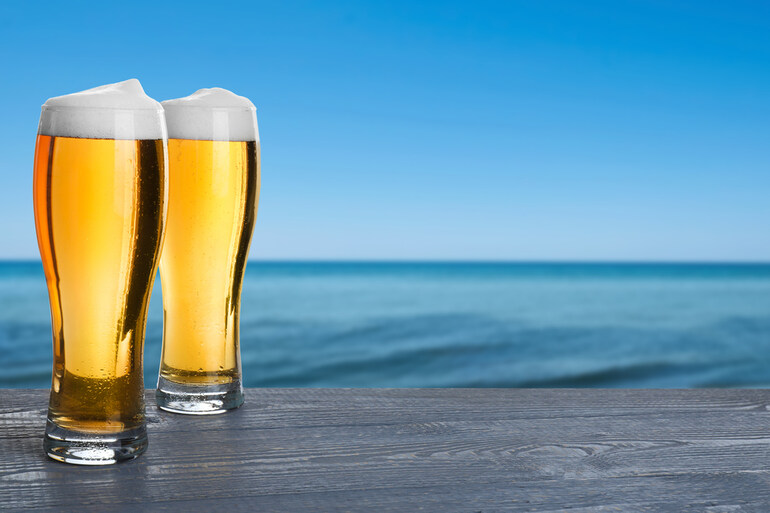Beer lovers are always in search of new experiences, whether it’s exploring unique craft brews, experimenting with homebrewing techniques, or attending beer festivals. But what if the environment itself could influence how we perceive beer? This question becomes especially intriguing aboard a craft beer cruise, where enthusiasts get to enjoy premium brews while sailing across open waters.
Could the ocean’s movement, air pressure, or even the salty breeze affect how beer tastes? To find out, we look at the science behind sensory perception and how a craft beer cruise offers a unique setting for beer evaluation.
The Science of Sensory Perception in Beer
Several elements determine our perceived beer flavor experience: aroma detection with taste elements and mouthfeel, impact together with carbonation levels. The sensory experience depends on both what is inside the beer and the external variables in the environment. Beer perception depends on several important factors:
- Aroma: Beer aromatics or volatile compounds transform according to altitude fluctuations and changes in air moisture.
- Taste: The pressure-sensitive taste buds react to changes in temperature and air pressure, resulting in altered perceptions of bitterness, sweetness, and acidity.
- Carbonation: Carbon dioxide absorption in beer shifts due to pressure and fluid motion, which affects the sensation of carbonation.
- Mouthfeel: Exterior elements affecting the senses produce altered perceptions of both body and texture during consumption.
The combination of alcohol-induced biases and water pressure fluctuations requires testing on a craft beer cruise to establish differences between sea-based beer tasting versus traditional land-based beer sampling.
The Experiment: Testing Beer Perception at Sea vs. Land
To determine if beer flavors change at sea, a controlled sensory experiment was conducted aboard a craft beer cruise. A group of beer enthusiasts participated in a blind tasting of the same beers in two different settings—first on land before departure and then again at sea during the cruise. The test included the following steps:
- Selection of Beers: The study included a choice of multiple craft beers, including IPAs, stouts, lagers, and sours, which allowed researchers to observe various flavor profiles.
- Controlled Pouring Conditions: All beers received controlled pouring service at the same temperature in both facilities to prevent serving delivery differences.
- Sensory Evaluation: Participants used a standardized beer evaluation form to rate the beers by evaluating aroma along with taste intensity and carbonation attributes and overall experience.
- Environmental Variables: Measurement of environmental factors including temperature, humidity, and air pressure occurred to determine their influence on the beer samples.
The Results: What Changed at Sea?
After analyzing the collected data, several interesting trends emerged:
- Aroma Perception Shifted: Assessments of IPA aromas conducted at sea displayed reduced strength for hop fragrances, especially the citrus and floral notes compared to standard land tasting conditions. The movement of sea breezes worked to speed up the evacuation of volatile compounds from their source.
- Carbonation Felt More Intense: Most participants noted enhanced carbonation intensity levels during sea-based beer Sea vessel motion likely heightened carbonation by causing beer agitation, thus strengthening its carbonation effect.
- Bitterness Perception Was Milder: Participants noticed a reduction in bitter hop taste strength for hop-forward beers including IPAs and pale ales while at sea. Variations in air pressure together with the change in humidity could impact the way individuals sensed bitterness through their taste buds.
- Mouthfeel Was Smoother: Participants noted that stout and porter beers exhibited a softer feel when drinking at sea. The slow swaying movement of ships may produce illusions of smoothness that can affect how people perceive their drinks.
- Enhanced Enjoyment Factor: The participants reported that beer tastes better because cruising provides an enchanting atmosphere which combines panoramic seascapes with pure breezes and peaceful surroundings to produce elevated enjoyment levels.
What Causes These Differences?
Research indicates multiple scientific reasons that could explain the modifications in beer sensory tasting evaluations while at sea.
- Air Pressure and Humidity: The breathing environment found on the open ocean produces atmospheric conditions that lead to slight alterations in how we detect food flavors and scents.
- Sensory Adaptation: The salty air with ship movements could successfully dull receptor sensitivity leading to changes in how we experience bitterness and carbonation.
- Psychological Factors: Changes in the craft beer cruise environment along with its unhurried mood substantially shape how customers perceive their drinks. The experience of relaxation on the cruise together with enjoyment tends to encourage people to rate the beers at higher values.
- Temperature Variability: The appearance of crispness in beer depends on cool service temperatures, whereas higher temperatures bring forward malt complexities.
A New Way to Enjoy Craft Beer
Scientific observations show that beer develops minor flavor changes during ocean transit, although these alterations do not always impact the beer negatively. The perception of hop bitterness seems to decline but malt sweetness becomes more pronounced. A combination of environmental conditions together with psychological factors and motion dynamics influences the taste experiences of beer in this particular space.
For craft beer enthusiasts, a craft beer cruise offers more than just an opportunity to enjoy great brews; it provides a unique sensory experience that challenges conventional beer tasting. Whether the changes in perception are due to science or simply the magic of the ocean, one thing is certain — sipping craft beer while surrounded by endless blue horizons is an unforgettable experience.








